
The Empress. The Hanged Man. The Chariot. Judgment. With their centuries-old iconography blending a mix of ancient symbols, religious allegories, and historic events, tarot cards can seem purposefully opaque. To outsiders and skeptics, occult practices like card reading have little relevance in our modern world. But a closer look at these miniature masterpieces reveals that the power of these cards isn’t endowed from some mystical source—it comes from the ability of their small, static images to illuminate our most complex dilemmas and desires.
“There’s a lot of friction between tarot historians and card readers about the origins and purpose of tarot cards.”
Contrary to what the uninitiated might think, the meaning of divination cards changes over time, shaped by each era’s culture and the needs of individual users. This is partly why these decks can be so puzzling to outsiders, as most of them reference allegories or events familiar to people many centuries ago. Caitlín Matthews, who teaches courses on cartomancy, or divination with cards, says that before the 18th century, the imagery on these cards was accessible to a much broader population. But in contrast to these historic decks, Matthews finds most modern decks harder to engage with.
“You either have these very shallow ones or these rampantly esoteric ones with so many signs and symbols on them you can barely make them out,” says Matthews. “I bought my first tarot pack, which was the Tarot de Marseille published by Grimaud in 1969, and I recently came right around back to it after not using it for a while.” Presumably originating in the 17th century, the Tarot de Marseille is one of the most common types of tarot deck ever produced. Marseille decks were generally printed with woodblocks and later colored by hand using basic stencils.

Top: A selection of trump cards (top row) and pip cards (bottom row) from the first edition of the Rider-Waite deck, circa 1909. Via the World of Playing Cards. Above: Cards from a Tarot de Marseille deck made by François Gassmann, circa 1870. Photo courtesy Bill Wolf.
However, using cards for playful divination probably goes back even further, to the 14th century, likely originating with Mamluk game cards brought to Western Europe from Turkey. By the 1500s, the Italian aristocracy was enjoying a game known as “tarocchi appropriati,” in which players were dealt random cards and used thematic associations with these cards to write poetic verses about one another—somewhat like the popular childhood game “MASH.” These predictive cards were referred to as “sortes,” meaning destinies or lots.
Even the earliest known tarot decks weren’t designed with mysticism in mind; they were actually meant for playing a game similar to modern-day bridge. Wealthy families in Italy commissioned expensive, artist-made decks known as “carte da trionfi” or “cards of triumph.” These cards were marked with suits of cups, swords, coins, and polo sticks (eventually changed to staves or wands), and courts consisting of a king and two male underlings. Tarot cards later incorporated queens, trumps (the wild cards unique to tarot), and the Fool to this system, for a complete deck that usually totaled 78 cards. Today, the suit cards are commonly called the Minor Arcana, while trump cards are known as the Major Arcana.

Two hand-painted Mamluk cards from Turkey (left) and two cards from the Visconti family deck (right), both circa 15th century.
Graphic designer and artist Bill Wolf, whose interest in tarot illustration dates to his art-school days at Cooper Union in New York, has his own theories about the tarot’s beginning. Wolf, who doesn’t use cards for divination, believes that originally, “the meaning of the imagery was parallel to the mechanics of the play of the game. The random draw of the cards created a new, unique narrative each and every time the game was played, and the decisions players made influenced the unfolding of that narrative.” Imagine a choose-your-own-adventure style card game.
“The imagery was designed to reflect important aspects of the real world that the players lived in, and the prominent Christian symbolism in the cards is an obvious reflection of the Christian world in which they lived,” he adds. As divinatory usage became more popular, illustrations evolved to reflect a specific designer’s intention. “The subjects took on more and more esoteric meaning,” says Wolf, “but they generally maintained the traditional tarot structure of four suits of pip cards [similar to the numbered cards in a normal playing-card deck], corresponding court cards, and the additional trump cards, with a Fool.”

This woodblock version of the classic Tarot de Marseille was published around 1751 by Claude Burdel. Photo courtesy Bill Wolf.
Even if you aren’t familiar with tarot-card reading, you’ve likely seen one of the common decks, like the famous Rider-Waite, which has been continually printed since 1909. Named for publisher William Rider and popular mystic A.E. Waite, who commissioned Pamela Colman Smith to illustrate the deck, the Rider-Waite helped bring about the rise of 20th-century occult tarot used by mystical readers.
“The Rider-Waite deck was designed for divination and included a book written by Waite in which he explained much of the esoteric meaning behind the imagery,” says Wolf. “People say its revolutionary point of genius is that the pip cards are ‘illustrated,’ meaning that Colman Smith incorporated the number of suit signs into little scenes, and when taken together, they tell a story in pictures. This strong narrative element gives readers something to latch onto, in that it is relatively intuitive to look at a combination of cards and derive your own story from them.
“The deck really took off in popularity when Stuart Kaplan obtained the publishing rights and developed an audience for it in the early ’70s,” says Wolf. Kaplan helped renew interest in card reading with his 1977 book, Tarot Cards for Fun and Fortune Telling, and has since written several volumes on tarot.
Though historians like Kaplan and Matthews publish new information on divination decks every year, there are still many holes in the larger story of fortune-telling cards. Wolf points out that those who use cards for divination are often at odds with academics researching their past. “There’s a lot of friction between tarot historians and card readers about the origins and purpose of tarot cards,” Wolf says. “The evidence suggests they were invented for gaming and evolved for use in divination at a much later date. Personally, I believe they were designed for game play, but that the design is a bit more sophisticated than many tarot historians seem to believe.”
“The earliest known tarot decks weren’t designed with mysticism in mind; they were actually meant for playing a game similar to modern-day bridge.”
By the mid-18th century, the mystical applications for cards had spread from Italy to other parts of Europe. In France, writer Antoine Court de Gébelin asserted that the tarot was based on a holy book written by Egyptian priests and brought to Europe by Gypsies from Africa. In reality, tarot cards predated the presence of Gypsies in Europe, who actually came from Asia rather than Africa. Regardless of its inaccuracies, Court de Gébelin’s nine-volume history of the world was highly influential.
Teacher and publisher Jean-Baptiste Alliette wrote his first book on the tarot in 1791, called “Etteilla, ou L’art de lire dans les cartes,” meaning “Etteilla, or the Art of Reading Cards.” (Alliette created this mystical pseudonym “Etteilla” simply by reversing his surname.) According to Etteilla’s writings, he first learned divination with a deck of 32 cards designed for a game called Piquet, along with the addition of his special Etteilla card. This type of card is known as the significator and typically stands in for the individual having their fortune read.
While the tarot is the most widely known, it’s just one type of deck used for divination; others include common playing cards and so-called oracle decks, a term encompassing all the other fortune-telling decks distinct from the traditional tarot. Etteilla eventually switched to using a traditional tarot deck, which he claimed held secret wisdom passed down from ancient Egypt. Etteilla’s premise echoed the writings of Court de Gébelin, who allegedly recognized Egyptian symbols in tarot-card illustrations. Though hieroglyphics had not yet been deciphered (the Rosetta Stone was rediscovered in 1799), many European intellectuals in the late 18th century believed the religion and writings of ancient Egypt held major insights into human existence. By linking tarot imagery to Egyptian mysticism, they gave the cards greater credibility.
Building on Court de Gébelin’s Egyptian connection, Etteilla claimed that tarot cards originated with the legendary Book of Thoth, which supposedly belonged to the Egyptian god of wisdom. According to Etteilla, the book was engraved by Thoth’s priests into gold plates, providing the imagery for the first tarot deck. Drawing on these theories, Etteilla published his own deck in 1789—one of the first designed explicitly as a divination tool and eventually referred to as the Egyptian tarot.

A few of the cards from Etteilla’s esoteric deck, reproduced by Grimaud in 1890. Photo courtesy Tero Goldenhill.
“Etteilla was one of the people who actually made divination so esoteric,” says Matthews. “He created a deck that incorporated all the things from Court de Gébelin and his book ‘Le Monde Primitif’ [‘The Primitive World’], which suggested an Egyptian origin for the tarot and all sorts of arcane things.” Matthews makes a distinction between the tarot’s abstract interpretations and the straightforward “cartomantic” reading style that thrived during the 16th and 17th centuries, prior to Etteilla.
“When we used to send telegrams, each word costs money,” Matthews explains, “so you’d have to send very few words like, ‘Big baby. Mother well. Come to hospital.’ And you’d get the gist of it. I read cards in a very similar way—starting from a few general keywords and making sense of them by filling in the words that are missing. This isn’t the tarot style of reading where you project things, like, ‘I can see that you’ve recently had a great disappointment. Mercury is in retrograde and da da da.’ A cartomantic reading is much more straightforward and pragmatic, for example, ‘Your wife will eat tomatoes and fall off the roof and die horribly.’ It’s a direct way of reading, a pre-New Age way of reading.”

One of Matthews’ favorite decks is the Lenormand published by Bernd A. Mertz in 2004 based on a design circa 1840. Photo courtesy Caitlín Matthews.
Matthews has authored several books on divinatory cards, and her latest, The Complete Lenormand Oracle Cards Handbook, will be published in October of this year. This 36-card deck was named after the celebrity card-reader Mademoiselle Marie Anne Lenormand, who was popular around the turn of the 18th and 19th centuries, though the decks bearing her name weren’t actually produced until after her death. The oldest packs in Matthews’ collection are two Lenormand-style decks, the French Daveluy of the 1860s and the Viennese Zauberkarten deck from 1864, which were some of the first decks to be illustrated using the technique of chromolithography.
“Your wife will eat tomatoes and fall off the roof and die horribly.”
Oracle decks like the Lenormand tend to rely on more direct visual language than traditional tarot cards. “The tarot can often speak in broad, timeless, universal statements about our place in the world,” says Wolf. “The imagery of fortune-telling decks is more illustrational and less archetypal. The images are generally more specific, simpler, and less universal, keeping the conversation more straightforward.”
In contrast to most oracle decks, which don’t include suited pip cards, Lenormand cards feature a unique combination of numbered playing-card imagery on top of illustrated scenes used for fortune-telling. “One of the earliest versions, called the Game of Hope, was made by a German named J.K. Hechtel and was prepared like a board game,” says Matthews. “You laid out cards 1 to 36, and the object of the game was to throw the dice and move your tokens along it. If you got to card 35, which was the anchor card, then you’re home, safe and dry. But if you went beyond that, it was the cross, which was not so good. It was like the game Snakes and Ladders.” In this way, the Game of Hope fell into the Victorian-era tradition of board games that determined a player’s life story based on luck.

This Lenormand-style oracle deck shows a mixture of playing card and fortune-telling illustrations, circa 1870. Photo courtesy Bill Wolf.
The game’s original instructions said it could be used for divining because the illustration on each card included both a symbolic image, like the anchor, and a specific playing card, like the nine of spades. “Hechtel must have seen that there were overlaps between divining with playing cards, which, of course, everyone did, and his game,” says Matthews. “Many other oracle decks appeared around the same time at the end of the 18th century and into the early 19th century. They became really popular after the Napoleonic Wars when everyone settled down and became terribly bourgeois.
“Quite recently, it was discovered by Mary Greer that there was a prior source to the Lenormand cards,” she continues. “There’s a deck in the British Museum called ‘Les Amusements des Allemands’ (‘The German Entertainment’). Basically, a British firm put together a pack of cards that has images and little epigrams on the bottom, which say things like, ‘Be aware, don’t spend your money unwisely,’ and that sort of thing. It’s quite trite. But it came with a book of text that’s almost identical to the instructions for later packs of Lenormand cards.”

“Les Amusements des Allemands,” circa 1796, has many overlaps with Lenormand decks. Via the British Museum.
By comparing various decks from different time periods, tarot-card enthusiasts can identify the evolution of certain illustrations. “For example,” says Matthews, “the modern version of the hermit with the lantern, you’ll find that that was an hourglass and he was Saturn or Chronos, the keeper of time. You can see how that translates with the Tarot Bolognese meaning of delay or blockage. It was about time moving slowly, though that’s not used as a modern meaning much now.”
Most card readers recognize that the associations and preconceptions of the person being read for are just as important as the actual drawings on the cards: Divination cards offer a way to project certain ideas, whether subconscious or not, and to toy with potential outcomes for important decisions. Thus, like scenes from a picture book, the best illustrations typically offer clear visions of their subjects with an open-ended quality, as though the action is unfolding before you.
Matthews’ favorite decks are those with straightforward illustrations, like the Tarocchino Bolognese by Giuseppe Maria Mitelli, an Italian deck created sometime around the 1660s. Matthews’ owns a facsimile of the Mitelli deck, rather than an original, which means she can use them without fear of damaging a priceless antique. “The deck that I enjoy most is the Mertz Lenormand deck because of its clarity,” she says. “The background on each card is a creamy, vellum color, so when you lay them out in tableau, you can see the illustrations very clearly. I frankly get so tired of all the new Photoshopped tarots and the slick art, with their complete lack of any framework or substance.
“I also enjoy reading with the Lenormand deck made by Daveluy, which has been beautifully reworked by Lauren Forestell, who specializes in restoring facsimile decks—cleaning up 200 years’ worth of card shuffling and human grief. The coloring on the Daveluy is very beautiful. Chromolithography gave an incredibly clear color to everything, and I think it was probably as revolutionary as Technicolor was in the days of the movies.”
The illustration on some decks did double duty, providing divinatory tools and scientific knowledge, like the Geografia Tarocchi deck from around 1725. “The Geografia are extraordinary cards, almost like a little encyclopedia of the world with the oracle imagery peeking out at the top,” Matthews says. “The actual bit that you read from is just a cigarette-card length. So for example, the hanged man just shows his legs at the top of the card, while the rest of the card has information about Africa or Asia or other places on it.”

On the Geografia deck, the symbolic imagery is reduced to a small colored segment at the top of each card; the rest is related to global geography. Via eBay.
In contrast, the meanings in other decks are particularly difficult to decipher, like the infamous Thoth tarot developed by Aleister Crowley, notorious for his involvement with various cults and experimentation with recreational drugs and so-called “sex magick.” Completed in 1943, the Thoth deck was illustrated by Lady Frieda Harris and incorporated a range of occult and scientific symbols, inspiring many modern decks. As Wolf explains, “with the rise of the divination market in the 20th century, more liberties were taken, and the imagery evolved into increasingly personal artistic statements, both in content and style of execution.”
But to balance such arcane decks, there are divinatory cards that offer little room for interpretation, like “Le Scarabée d’Or” or The Golden Beetle Oracle, one of Wolf’s most prized decks. “It’s just fantastically bizarre. There’s a little window in the lid of the card box, and when you shake it, the beetle appears, and points to a number,” he explains. “Then you find the corresponding number on a set of round cards, with beautiful script text on them, and read your fortune. Can you not imagine standing in a Victorian parlor in France, consulting the Golden Beetle? It was like performance art.”
The Art of Divination Cards
(If you buy something through a link in this article, Collectors Weekly may get a share of the sale. Learn more.)















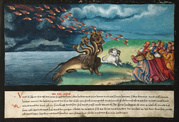
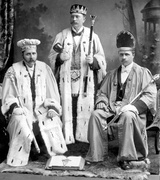 Decoding Secret Societies: What Are All Those Old Boys' Clubs Hiding?
Decoding Secret Societies: What Are All Those Old Boys' Clubs Hiding?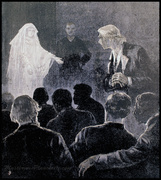
 Storybook Apocalypse: Beasts, Comets, and Other Signs of the End Times
Storybook Apocalypse: Beasts, Comets, and Other Signs of the End Times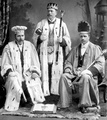 Decoding Secret Societies: What Are All Those Old Boys' Clubs Hiding?
Decoding Secret Societies: What Are All Those Old Boys' Clubs Hiding?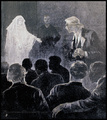 Ghosts in the Machines: The Devices and Daring Mediums That Spoke for the Dead
Ghosts in the Machines: The Devices and Daring Mediums That Spoke for the Dead Tarot CardsThough known today as a mystical practice for reading fortunes, the tarot b…
Tarot CardsThough known today as a mystical practice for reading fortunes, the tarot b… Mari Tepper: Laying it on the Line
Mari Tepper: Laying it on the Line Nice Ice: Valerie Hammond on the Genteel Charm of Vintage Canadian Costume Jewelry
Nice Ice: Valerie Hammond on the Genteel Charm of Vintage Canadian Costume Jewelry How Jim Heimann Got Crazy for California Architecture
How Jim Heimann Got Crazy for California Architecture Modernist Man: Jock Peters May Be the Most Influential Architect You've Never Heard Of
Modernist Man: Jock Peters May Be the Most Influential Architect You've Never Heard Of Meet Cute: Were Kokeshi Dolls the Models for Hello Kitty, Pokemon, and Be@rbrick?
Meet Cute: Were Kokeshi Dolls the Models for Hello Kitty, Pokemon, and Be@rbrick? When the King of Comedy Posters Set His Surreal Sights on the World of Rock 'n' Roll
When the King of Comedy Posters Set His Surreal Sights on the World of Rock 'n' Roll How One Artist Makes New Art From Old Coloring Books and Found Photos
How One Artist Makes New Art From Old Coloring Books and Found Photos Say Cheese! How Bad Photography Has Changed Our Definition of Good Pictures
Say Cheese! How Bad Photography Has Changed Our Definition of Good Pictures Middle Earthenware: One Family's Quest to Reclaim Its Place in British Pottery History
Middle Earthenware: One Family's Quest to Reclaim Its Place in British Pottery History Fancy Fowl: How an Evil Sea Captain and a Beloved Queen Made the World Crave KFC
Fancy Fowl: How an Evil Sea Captain and a Beloved Queen Made the World Crave KFC
A fascinating (and well written) article, thank you.
What an excellent, interesting, focused, well-written, substantive article. Thank you so very much. Your timing is perfect. Shared liberally.
Very informative post, I love Tarot history and have been collecting decks for about 40 yrs – Recently I’ve been enjoying the Sola Busca Tarot (Northern Italy, 1491 ca.) – just got one of the few rare decks left that were created as exact replicas of the originals (recreated by Wolfgang Mayer, 1998). Sola Busca is the oldest fully illustrated decks (major and minor arcana illustrated), and is the one Pamela Colman Smith most likely saw the black and write drawings of in the museum (they were on display at the time) and used as inspiration for the Waite-Smith deck (a comparison of the two decks shows a lot similarities)
Another *interesting* deck intentionally esoteric was Crowley’s Ordo Templi Orientis cards. New Age way before its time. Or maybe not, the twenties did see a lot of interesting esoterica. Even T S Eliot got into the act.
What an excellent, interesting focused well written substantive article, A big thank u sooo very much for ur time is perfect XX
I really found that interesting thank you….
I love the magic cards
Excellent article. Thanks for keeping this online :-)
A very interesting and informative article. Understanding the history of the cards gives me a insight into the richness of the tarot cards..
…. pretty good article historically speaking, although there is no mention of their use for any other purpose but mundane games and fortune-telling. Either the author is sworn to secrecy (which I doubt) or is completely ignorant of the esoteric utility of the Tarot as was rediscovered and promulgated by S.L. Mathers and his Golden Dawn near the end of the 19th century. Nor is there any mention of either Aleister Crowley or Paul Foster Case, both of whom followed Mather’s suit (pun intended) in their esoteric use of the Tarot as a system of spiritual work and initiation. I am assuming, by the tenor of the article, that the author is among those who deny their mystical history and properties. Yawn.
…so, is there a relation to the Mexican (and originally Italian) Loteria card game?
@Nox
Since this article is about the origin of the cards, and not their subsequent modern use, going over their current mystical connotations would be not only nonsensical, but redundant as well.
And Crowley’s got a cameo in the gallery, even.
A great article. I have a small collection of decks. Though I no longer “play” at divination, I still find them beautiful. Coming from an Italian family, my mother “read the cards”, but she used a deck of regular playing cards. She was spooky good at it, too.
Great article . It is interesting that early versions of The Lovers was called The Lover and showed a man, two women as well as the Cherub. ( Cupid figure ) I think it offers up different associations to what we find today
Wow. Collecting and learning such fascinating history. I collect all kinds of games and this has made me become interested in learning the rules for the various “bridge” games played with both Arcana.
The tarot offers moral allegories somewhat lost for modern tastes. E.g for that Lovers card, the two women and a man were from a popular classical trope ‘The choice of Hercules’ where Hercules on his journeys meets two women at a crossroads ‘Virtue and Vice’ and has to choose between pleasure or duty. I personally believe the major trumps were also mnemonics for constellations of the time, besides being a game.
The correct translation of Le Scarabée d’Or is The Gold Beetle or The Beetle of Gold. If it was simply a golden beetle it would be Le scarabée doré, because the french also have two different words for gold and golden, and in the french language is very important to set this difference. While in the english language saying that something is golden means it can either be made of gold or just have a golden appearance (by being painted or polished to look golden), in the french language saying that something is golden means that is definitely NOT made of gold but that it just has a golden look. Le scarabée d’or is referring to a beetle actually made out of gold and therefore valuable. Great article, though, with lots of valuable information. Thanks!
A wonderfully informative article. I was fascinated with the idea of the early Mamluk games and the fact that the cards were referred to a ‘lots or destinies.’ The ancient Jewish festival of Purim. as told in the Book of Esther, is set in the Middle East (Shushan) and involved the drawing of the ‘pur/purim’ or ‘lot/lots’ to determine the appropriate date to annihilate the Jewish community. I had never made the possible connection with the forerunners to cards and this ancient story:-)
Interesting and useful. Thank you.
Great, informative, and facinating article. Thank you
Wow, it is interesting. The article helps me understand clearly the origin of Tarot. But, can we use Tarot cards for future predictions? Are these accurate?
GREAT ARTICLE BUT STILL HAVE DOUBTS.
G*psy is seen as pejorative by many and Romani (and other variations) is preferred to replace this term.
Well written and so interesting
Thank you!
I discredited the validity of the whole article once I read the gypsies came from Asia not Africa. People create the history and facts they want to believe.
Hmmm. I’m trying to figure out what the person who wrote comment #25 meant.
It seems pretty well established via linguistic, and more recently, DNA evidence that the ethnic group known as “Gypsy” or “Rom” has its origins in the Indian subcontinent, which would be Asia.
Fascinating, informative, and well composed. I have a suspicion that the Tarot was created around the year 1006 near the appearance of the Nova of that year. The private label period from about 1006 to the appearance of the earliest known decks in the mid 1450s had to await the invention of the printing press in 1440. Prior to this the deck had to be produced from the collection of images, diagrams and notes developed in Andalusia by many of the same folks who gave us the Picatrix. Originally, if my thesis is correct, the Tarot was a short cut method for answering questions similar to an astrological method called horary astrology. The deck contains a full representation of traditional astrology for that purpose but has found many other uses and expressions and, as is seen with astrology and magic, as the times changed, the basics remained but the presentation changed with the times. This is especially true with the dawn of the Enlightenment and the shift in how we view the world. The Tarot is now useful for entertainment, divination, answring questions, meditation and spiritual exploration, and magical focus. The above article gives an excellent consideration of the emergence of the Tarot from the invention of the printing press to the start of the 20th century. There are three periods so far : What I call the private label period 1006 to about 1440, the development or public label period about 1450 (Visconti-Sforza) to abut 1900, and the modern period (Levy, Rider-Waite, Crowley) from about 1900 to the present. But, perhaps this last period needs further division. There are also astrological markers for these periods. I’m working on a book to share this thesis and am greatly indebted to your research and insights.
@Jonathan Flanery
Your comment sounds very interesting and intriguing. I would be interested in your book!
I know I’m here very late and the author will probably never see this, but THANK YOU. What a great report. I’m researching the origins and history of tarot for my podcast about mystic, unexplained things, and this has helped so much. Thank you!!!
Dear folks, NO – the Tarot comes from the text of the Hebrew Torah. I have spent the past 24 years working with the image set in the letter patterns of the Hebrew Torah. And it DOES come from something sacred. For too long it has gone profaned. and it is time the truth was known and your story is not it. https://www.colunga-hernandez.com/index.html
Thank you,
I am respectfully yours,
Rev. Manuel Colunga-Hernandez
I enjoyed this article, it was very informative and an easy read. I appreciate each of the photo illustrations. I learned so much thank you!
Interesting article! Before reading about Tarot in this article my only exposure was through the “Shin Megami Tensei: Persona” games. I got lead to this article from a link on Fishtank Learning because I am teaching my students about “The House on Mango Street” by Sandra Cisneros. As I was reading the vignette, “Elenita, Cards, Palm, Water” I wonder how many of my 7th graders know about the Tarot and its history. If you were teaching 7th graders about Tarot cards, how would you do it. Thanks for sharing!